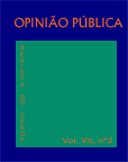Resumo
Medidas de mudança em pares de variáveis atitudinais podem proporcionar insights Importantes sobre a estrutura dos sistemas de crenças políticas dos públicos de massa. Dados de painéis revelam evidências da grande centralidade de alguns elementos de idéias em vez de outros no contexto de constrangimento dinâmico de curto prazo. A especificação dos atributos teoricamente relevantes dos eleitores torna possível testar diferenças estruturais esperadas que conectam predisposições relacionadas a políticas e preferências por políticas; a especificação também torna possível testar proposições que envolvem os efeitos recíprocos de atitudes e preferências emergentes de voto. Algumas das especificações mais úteis revelam até que ponto a heterogeneidade da população produz uma imagem embaçada de relações quando a análise se baseia no eleitorado total, em vez de se limitar a eleitores ou subconjuntos de eleitores especificados por critérios teóricos.
Abstract
Measures of change in pairs of attitudinal variables can provide important insights into the structure of the political belief systems of mass publics. Panel data reveal evidence of the greater centrality of some idea elements rather than others in the context of short-term dynamic constraint. Specification of the theoretically relevant voter attributes makes it possible to test for expected structural differences connecting policy related pre-dispositions and policy preferences; specification also makes it possible to test propositions involving the reciprocal effects of attitudes and emerging vote preferences. Some of the more helpful specifications disclose the extent to which population heterogeneity produces a blurred image of relationships when analysis is based on the total electorate rather than limited to voters or subsets of voters specified by theoretical criteria.
Key words: belief systems, attitudinal variables, vote preferences, causal relation
Referências
ALWIN, D. P. & HAUSER, R. M. (1975) The Decomposition of Effects in Path Analysis. American Sociological Review, 40:37–47.
BARTELS, Larry. (1988) Presidential Primaries and the Dynamics of Public Choice. Princeton, NJ: Princeton University Press.
BLALOCK, Hurbert M., Jr. (1961) Causal Inferences in Nonexperimental Research. Chapel Hill: University of North Carolina Press.
BLALOCK, Hurbert M. (1971) Causal Models in the Social Sciences. Nova York: Aldine/Atherton.
BRADY, Henry & JOHNSTON, Richard. (1987) What’s the Primary Message: Horse Race or Issue Journalism. In: Media and Momentum, eds. Gary R. Orren e Nelson W. Polsby. Chatham, NJ, pp. 127–186.
BRODY, Richard A. & PAGE, Benjamin I. (1972) The Assessment of Policy Voting. American Political Science Review, 66:450–458.
BRODY, Richard A. et al. (1969) Vietnam, the Urban Crisis and the 1968 Election. Trabalho apresentado na Reunião Anual da American Sociological Association, San Francisco.
CAMPBELL, A., CONVERSE, Philip E., MILLER, Warren E. & STOKES, Donald E. (1976) The American Voter. Chicago: University of Chicago Press.
CAMPBELL, James & GARAND, James. (2000) Before the Vote: Forecasting the 1996 American National Elections. Thousand Oaks, CA: Sage.
CONVERSE, Philip E. (1962) Information Flow and Stability of Partisan Attitudes. Public Opinion Quarterly, 26:578–599.
CONVERSE, Philip E. (1964) The Nature of Belief Systems in Mass Publics. In: Ideology and Discontent, ed. David Apter. Nova York: Free Press.
DAVIS, James A. (1985) The Logic of Causal Order. Beverly Hills, CA: Sage.
FIORINA, Morris P. (1981) Retrospective Voting in American National Elections. New Haven, CT: Yale University Press.
GEER, John. (1988) What Do Open-Ended Questions Measure? Public Opinion Quarterly, 52:365–370.
GREEN, Donald P. & PALMQUIST, Bradley. (1990) Of Artifacts and Partisan Instability. American Journal of Political Science, 34:872–902.
JACKSON, John E. (1975) Issues, Parties and Presidential Votes. American Journal of Political Science, 19:167–185.
JENNINGS, M. Kent & MARKUS, Gregory B. (1984) Partisan Orientations over the Long Haul: Results from the Three-Wave Political Socialization Panel Study. American Political Science Review, 78:1000–1018.
JENNINGS, M. Kent & MARKUS, Gregory B & NIEMI, Richard G. (1981) Generations and Politics: A Panel Study of Young Adults and Their Parents. Princeton, NJ: Princeton University Press.
KENDALL, Patricia L. & LAZARSFELD, Paul F. (1950) Problems of Survey Analysis. In: Continuities in Social Research: Studies in the Scope and Method of “The American Soldier,” eds. R. K. Merton e P. P. Lazarsfeld. Glencoe, IL: Free Press, pp. 148–154.
MILLER, Warren E. & SHANKS, J. Merrill. (1982) Policy Directions and Presidential Leadership: Alternative Interpretations of the 1980 Presidential Election. British Journal of Political Science, 12:299–356.
MILLER, Warren E. & SHANKS, J. Merrill. (1996) The New American Voter. Cambridge, MA: Harvard University Press.
RABINOWITZ, George & MacDONALD, Elaine Stuart. (1989) A Directional Theory of Issue Voting. American Political Science Review, 83:93–121.
ROSENBERG, Morris. (1968) The Logic of Survey Analysis. Nova York: Basic Books.
SHANKS, J. Merill & MILLER, Warren E. (1990) Policy Direction and Performance Evaluation: Complementary Explanation of the Reagan Elections. British Journal of Political Science, 20:143–235.
SHANKS, J. Merill & MILLER, Warren E. (1991) Partisanship, Policy and Performance: The Reagan Legacy in the 1988 Election. British Journal of Political Science, 21:129–197.
TEIXEIRA, Ruy. (1984) Why Americans Don’t Vote. Westwood: Greenwood Press.
WRIGHT, Sewall. (1921) Correlation and Causation. Journal of Agricultural Research, 20:557–585.
ZALLER, John. (1992) The Nature and Origins of Mass Opinions. Nova York: Cambridge University Press.
A Opinião Pública utiliza a licença do Creative Commons (CC), preservando assim, a integridade dos artigos em ambiente de acesso aberto.

